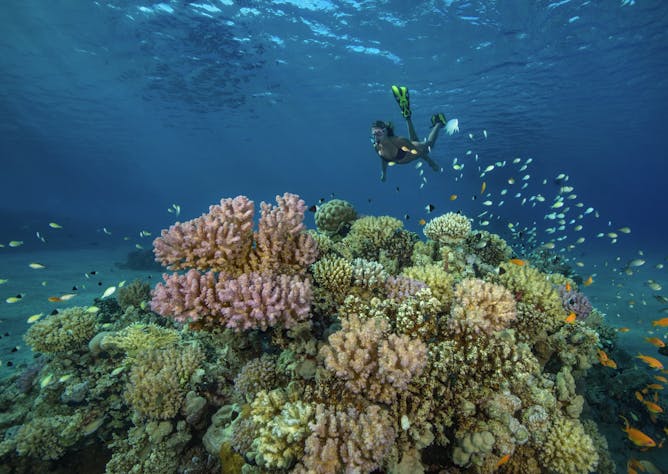|
In the last few years, scientists have found evidence that a chemical in sunscreen can harm coral reefs. It is common to find “reef-safe” sunscreens in stores that are made without the coral-harming chemical, oxybenzone.
Despite governments banning sunscreens containing oxybenzone – which normally protects cells from harmful ultraviolet light – nobody actually knew the biology of how or why it was killing corals. Djordje Vuckovic and Bill Mitch are civil and environmental engineers who study chemical pollutants. They asked an obvious but important question: If nobody knows exactly why normal sunscreens are harming reefs, how could anyone know “reef-safe” sunscreens are actually safe for reefs?
Working with a team of biologists, they designed a clever experiment to understand how oxybenzone harms corals. Using sea anemones, acrylic UV sunglasses and a lot of chemical analysis, they found that a common cellular process actually converts oxybenzone into a sunlight-activated toxin that can kill corals and anemones.
Also today:
|

|
Daniel Merino
Assistant Science Editor & Co-Host of The Conversation Weekly Podcast
|
|

Many places have banned sunscreens with certain chemicals in an attempt to help protect coral reefs.
Westend61 via Getty Images
Djordje Vuckovic, Stanford University; Bill Mitch, Stanford University
Researchers have long suspected that an ingredient in sunscreen called oxybenzone was harming corals, but no one knew how. A new study shows how corals turn oxybenzone into a sunlight-activated toxin.
|
Environment + Energy
|
-
Rachel Thrasher, Boston University; Blake Alexander Simmons, Colorado State University; Kyla Tienhaara, Queen's University, Ontario
A new study adds up the potential legal and financial risk countries could face from hundreds of agreements, like those under the Energy Charter Treaty.
-
Matthew Siegfried, Colorado School of Mines; Chloe Gustafson, University of California San Diego
Liquid water below the ice determines how fast an ice stream flows. As the ice sheet gets thinner, more of that salty groundwater could rise.
|
|
Politics + Society
|
-
Jordan Cohen, George Mason University
An arms trade expert explains the wide variety of military aid nations around the world have sent to Ukraine.
-
Bernard Loesi, University of Washington
The US gives money to help Indonesia and other countries fight terrorism. But research shows that this money might not be effective, unless it directly reaches former extremists.
-
Treva B. Lindsey, The Ohio State University
With the Supreme Court likely to strike down constitutional protection for abortion, a centuries-old debate over its morality and legality has been reignited.
|
|
|
|
Education
|
-
Michelle Samura, Chapman University
Just what does it mean for students to feel as if they “belong” on campus? A researcher weighs in.
|
|
Science + Technology
|
-
Isobel Routledge, University of California, San Francisco
Your blood can hold a record of past illnesses. That information can reveal how many people have had a certain infection – like 58% of Americans having had COVID-19 by the end of February 2022.
|
|
Ethics + Religion
|
-
Susan L Trollinger, University of Dayton; William Trollinger, University of Dayton
Two scholars of fundamentalism and creationism explain what they found when they visited the Ark Encounter, an evangelical theme park in Kentucky,
-
Lena Surzhko Harned, Penn State
World War II has a central place in Russian nationalism. Its importance is written all over a new cathedral dedicated to the armed forces.
|
|
Podcast 🎙️
|
-
Gemma Ware, The Conversation; Daniel Merino, The Conversation
In this episode of The Conversation Weekly podcast, we also explore the reasons by India’s neutrality over the Ukraine war.
Also: Please take our survey to help us make our podcasts better. Click here to take the survey.
|
|
From our international editions
|
|
|
|
Today's quiz 🧠 |
|---|
| | More from The Conversation US |
|---|
| |
|
| |
| |
| |
| |
|
|